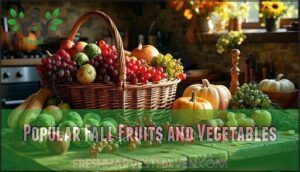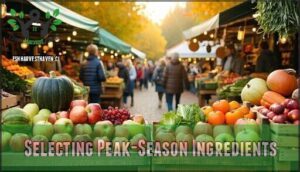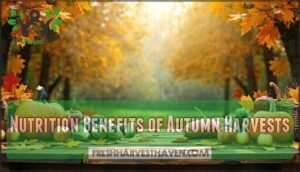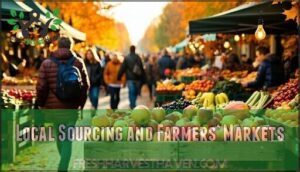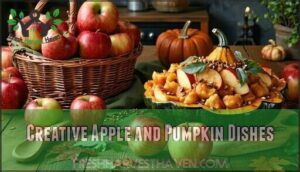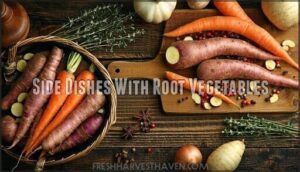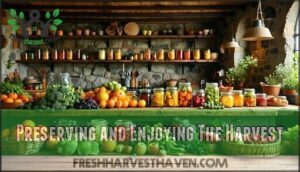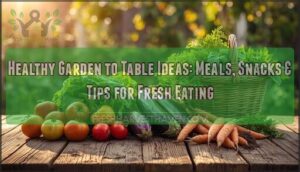This site is supported by our readers. We may earn a commission, at no cost to you, if you purchase through links.
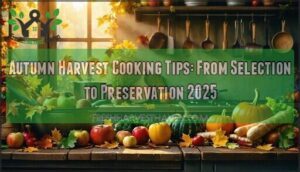
Roasting brings out natural sweetness in squash and root vegetables, while gentle braising works wonders for tougher autumn greens.
Don’t overlook preservation techniques—canning and freezing lock in nutrients and extend your harvest’s life well into winter months. The secret lies in proper timing and temperature control, whether you’re caramelizing onions or making apple butter from scratch.
Table Of Contents
- Key Takeaways
- Defining Autumn: Season and Significance
- Choosing The Best Autumn Produce
- Essential Autumn Cooking Techniques
- Flavorful Autumn Harvest Recipes
- Preserving and Enjoying The Harvest
- Frequently Asked Questions (FAQs)
- What are some fall harvest foods?
- What is the most famous food in autumn?
- What to cook for dinner in autumn?
- What spices complement autumn harvest flavors best?
- How long do fresh fall vegetables stay good?
- Which cooking methods enhance seasonal produce nutrients?
- Can you substitute winter squash varieties interchangeably?
- What kitchen tools make fall prep easier?
- What spices work best with autumn vegetables?
- How long should I roast different root vegetables?
- Conclusion
Key Takeaways
- Select peak-season produce wisely – Look for firm, unblemished fruits and vegetables at farmers’ markets, checking for visual cues like vibrant colors, proper weight, and fresh aromas to ensure you’re getting ingredients at their nutritional and flavor peak.
- Master essential cooking techniques – Roasting at 425°F brings out the natural sweetness in root vegetables, while proper sautéing and braising transform tough autumn greens into tender, flavorful dishes that showcase seasonal ingredients.
- Preserve your harvest properly – Use tested canning recipes, blanch vegetables before freezing, and store different produce types correctly (apples in perforated bags, root vegetables in cool, dark spaces) to extend freshness well into winter.
- Focus on timing and temperature control – Whether you’re caramelizing onions, making apple butter, or roasting Brussels sprouts, controlling heat and cooking times ensures you capture autumn’s best flavors while maintaining food safety standards.
Defining Autumn: Season and Significance
Autumn marks more than just cooler weather—it’s when nature puts on its grand finale before winter’s arrival.
Understanding the science behind those vivid reds and golds, plus the cultural traditions that celebrate this bountiful season, helps you make the most of autumn’s exceptional harvest offerings.
Meteorological Vs. Astronomical Autumn
When you’re planning your autumn cooking, you might wonder if there’s actually a difference between when the season officially starts versus when it feels like fall in your kitchen. There’s definitely a distinction.
Meteorological autumn begins September 1st, making it easier for weather tracking and temperature comparisons. Astronomical autumn starts with the equinox around September 22nd, when daylight hours equal nighttime.
Regional variations mean your local produce might peak earlier or later than these official dates.
History of Autumn and Fall
The etymology of autumn reveals fascinating linguistic evolution. Originally called "harvest" in medieval England, this term became confusing since it described both the season and crop-gathering activities. "Autumn" emerged around 1300 from Latin "autumnus," while "fall" appeared in the 1600s, referencing falling leaves. Fall’s Americanization occurred by the mid-1800s, creating the distinct British-American divide we see today. The season is celebrated globally, with many cultures observing unique harvest festivals.
- Ancient harvest festivals connected communities through shared gratitude and abundance celebrations
- The autumnal equinox guided agricultural timing for civilizations from Mayans to Romans
- Global traditions like China’s Mid-Autumn Festival show autumn’s universal cultural significance across continents
Science Behind Leaf Color Changes
Ever wonder why your backyard transforms into nature’s own art gallery each fall, painting trees in vibrant reds, oranges, and golds? It’s all about chlorophyll degradation—as temperatures drop and daylight shortens, trees stop producing this green pigment.
Without chlorophyll masking them, carotenoids reveal their yellow and orange hues, while anthocyanin synthesis creates those stunning reds. Environmental factors like cool nights and sunny days boost these chemical reactions, giving us autumn’s wondrous show.
Cultural Festivals and Harvest Traditions
Autumn brings communities together around the world through harvest celebrations. More than 50 countries hold harvest festivals, from China’s Mid-Autumn Festival with 1 billion people taking part to Thanksgiving with its 282 million celebrants.
These Global Celebrations showcase Regional Customs—Japan’s 1,300-year rice ceremonies, Korea’s ancestral Chuseok rituals, and Ireland’s Samhain bonfires. Many of these festivals, like Oktoberfest in Germany, attract visitors globally.
These festivals pack a real economic punch too. Indiana’s Harvest Homecoming alone brings in $11 million for the local community.
But the money’s just part of it—these traditions actually bring people closer together. Research shows community trust jumps 24% during Thanksgiving and harvest season, helping pass down cultural traditions from one generation to the next.
Choosing The Best Autumn Produce
The secret to outstanding autumn cooking starts with selecting the right produce at its seasonal peak.
You’ll discover how to identify the freshest apples, pumpkins, and root vegetables while understanding their nutritional benefits and finding the best local sources.
Popular Fall Fruits and Vegetables
Nature’s candy counter opens wide in autumn, showcasing ruby-red apples, golden butternut squash, and emerald Brussels sprouts that practically beg to be transformed into something magical. These seasonal vegetables and fall harvest produce deliver peak flavors that’ll make your autumn cooking shine.
Top Fall Harvest Produce:
- Apple varieties – Honeycrisp, Granny Smith, Gala
- Pumpkin types – Sugar pie, butternut, acorn squash
- Root vegetables – Sweet potatoes, carrots, parsnips
- Seasonal berries – Cranberries, late raspberries, elderberries
Selecting Peak-Season Ingredients
Walking through the produce section can feel like a treasure hunt when you know the telltale signs of peak-season prime condition. Your eyes become your best tool for spotting visual quality cues, while your nose picks up aromatic intensity that signals fall harvest readiness.
Produce Peak Ripeness Indicators
Apples
Pumpkins
Winter Squash
Pears
Sweet Potatoes
Seasonal availability guides your choices toward sustainable sourcing, connecting you with nature’s rhythm while making sure your fall harvest recipes showcase seasonal fall produce at its absolute best.
Nutrition Benefits of Autumn Harvests
Fall’s produce hits different when the weather turns cold. Pumpkins and sweet potatoes are loaded with vitamin A to keep your immune system strong, while apples bring vitamin C and fiber that your heart loves.
Brussels sprouts pack a serious vitamin C punch—one cup gives you 93% of what you need daily for immune support.
These fall favorites loaded with antioxidants don’t just boost your defenses; they keep your gut happy and deliver the nutrients your body craves as temperatures drop.
Local Sourcing and Farmers’ Markets
There’s something magical about connecting directly with the hands that grew your dinner, and autumn farmers’ markets are where those connections flourish best.
Market benefits extend beyond fresh seasonal produce—you’re supporting farmers while discovering peak-season ingredients for your fall recipes.
These community impact hubs showcase sustainable practices, offering local food that transforms your autumn cooking with flavors you can’t find in supermarkets.
Essential Autumn Cooking Techniques
Fall’s bounty deserves cooking methods that bring out each ingredient’s natural flavors and textures. Mastering techniques like roasting root vegetables, sautéing leafy greens, and safely handling seasonal produce will transform your autumn kitchen into a hub of warmth and delicious aromas.
Roasting and Baking Fall Vegetables
When you crank your oven to 425 degrees and toss those vibrant fall vegetables with olive oil, you’re not just cooking—you’re coaxing out flavors that summer never knew existed. Root vegetables like carrots and parsnips develop natural sweetness levels that’ll surprise you, while Brussels sprouts transform from bitter to nutty excellence.
Here’s your roasting game plan:
- Cut vegetables uniformly – Same-sized pieces mean even baking times and consistent results
- Single layer rule – Crowded pans steam instead of roast, robbing you of those caramelized edges
- Flip halfway through – Turn your seasonal vegetables once for balanced browning and choice texture
Sautéing and Braising Seasonal Produce
Quick sautés and slow braises might seem like opposites, but they’re your best friends for coaxing the sweetest flavors from fall’s tender vegetables and sturdy greens. Sautéing techniques shine with bell peppers and mushrooms, while braising liquids transform tough kale into silky smoothness.
| Sautéing Stars | Braising Champions |
|---|---|
| Bell peppers | Collard greens |
| String beans | Carrots |
| Mushrooms | Parsnips |
| Onions | Brussels sprouts |
| Apple slices | Root vegetables |
Control texture by adjusting heat and timing for perfect recipe adaptations.
Poaching and Grilling Fall Fruits
Fall fruits transform into something magical when you master the gentle art of poaching or embrace the bold char of the grill. Poaching apples and pears in spiced wine creates tender, aromatic desserts, while grilling plums and stone fruits develops deep caramelization secrets through natural sugar concentration and smoke infusion.
Essential techniques for perfect results:
- Poached fruit spices – Cinnamon, star anise, and vanilla pods infuse gentle warmth
- Grilled fruit glazes – Honey or maple syrup creates beautiful caramelized surfaces
- Temperature control – Medium heat prevents burning while developing flavor
- Dessert pairings – Serve with vanilla ice cream or whipped cream for contrast
Safe Food Handling and Preparation Tips
You wouldn’t dream of serving a beautiful autumn feast that makes your guests sick, so let’s talk about keeping those gorgeous seasonal ingredients safe from farm to table. Proper handling prevents bacteria from crashing your harvest party.
| Step | Action | Why It Matters |
|---|---|---|
| Wash Produce | Scrub for 20+ seconds under running water | Removes dirt, pesticides, and harmful bacteria |
| Avoid Cross-Contamination | Keep raw meats separate from vegetables | Prevents dangerous bacterial transfer |
| Safe Temperatures | Cook to proper internal temps, refrigerate within 2 hours | Stops bacterial growth in your seasonal cooking |
| Storage Practices | Clean utensils between different ingredient prep | Maintains food safety across all cooking methods |
These simple steps protect your fall recipes while letting those gorgeous autumn flavors shine through your vegetable preparation techniques.
Flavorful Autumn Harvest Recipes
Now that you’ve mastered the essential cooking techniques, it’s time to put them to work with recipes that celebrate autumn’s amazing bounty.
From warming soups that fill your kitchen with delightful aromas to creative dishes featuring apples and pumpkins, these recipes transform seasonal ingredients into memorable meals your family will crave all season long.
Cozy Soups, Stews, and Comfort Foods
Nothing beats the warmth of a steaming bowl when autumn’s chill starts creeping through your kitchen windows.
Your slow cooker stews become champions here, transforming tough root vegetables into tender comfort food gold.
Rich, hearty broth choices anchor these autumn cuisine classics, while fall spice blends like cinnamon and nutmeg add soul-warming depth to every spoonful you savor.
Creative Apple and Pumpkin Dishes
Apples and pumpkins are autumn’s golden duo, but they’re often trapped in the same tired recipes year after year. Break free with Apple Pumpkin Fusion creations like pumpkin-apple gnocchi or spiced apple-stuffed acorn squash.
Try Savory Pumpkin Dishes beyond soup—think pumpkin risotto with crispy pumpkin seeds.
Don’t overlook Apple Butter Variations in glazes for roasted meats, transforming your Autumn cuisine into something memorable.
Side Dishes With Root Vegetables
Root vegetables are autumn’s underground treasures, transforming from humble earth dwellers into show-stopping side dishes that steal the spotlight from any main course. These root vegetable varieties — carrots, parsnips, turnips, and sweet potatoes — reach their peak during fall harvest season.
Roasting root vegetables at high heat caramelizes their natural sugars, while braising root vegetables creates tender, flavorful autumn dishes. Pair them with seasonal spices like thyme and rosemary for unforgettable vegetable side dishes that complement any vegetable recipes collection.
Autumn Cocktails and Seasonal Drinks
This fall, bartenders are diving deep into forest flavors—think juniper, pine, and other woodsy ingredients that show up in about two-thirds of seasonal cocktails.
At the same time, Gen Z is pushing the low-alcohol trend forward, hunting for mocktails that actually do something beyond just taste good.
Whiskey’s having a moment this fall, grabbing more shelf space while everyone’s reaching for pumpkin spice and apple cider flavors.
Try Signature Cocktails like Cranberry Old Fashioned or Apple Cider Mimosas for perfect Fall Recipes that complement your Pumpkin recipes and Apple recipes.
Preserving and Enjoying The Harvest
You can’t enjoy autumn’s bounty year-round without proper preservation techniques that lock in peak flavors and nutrients.
Smart storage methods, from traditional canning to modern freezing approaches, help you savor the harvest long after the last leaf falls.
Canning and Pickling Methods
Preserving your autumn bounty through canning and pickling transforms fleeting seasonal flavors into year-round treasures that’ll make your pantry sing with memories of harvest time.
Start with proper jar sterilization—boiling your mason jars for ten minutes ensures canning safety. Choose quality pickling spices like mustard seed and bay leaves for pickled beets, while pumpkin butter requires careful pH monitoring.
Follow tested recipes religiously; safe preserving methods aren’t negotiable when you’re storing food long-term.
Freezing and Dehydrating Produce
When your harvest overflows and you can’t possibly eat everything before it spoils, freezing and dehydrating become your kitchen’s best friends for locking in that peak autumn flavor. Blanch vegetables like Brussels sprouts before freezer storage to maintain their vibrant autumn colours.
Food dehydrators work wonders for apple slices and kale chips, while frozen meals prep becomes straightforward with pre-portioned seasonal cooking tips.
Making Jams, Preserves, and Fruit Butters
Transform your autumn bounty into liquid gold by mastering the ancient art of jam-making, where a simple pot becomes your gateway to capturing summer’s last whispers in jewel-toned jars.
You’ll need proper sugar ratios—commonly one-to-one with fruit—and pectin science to achieve that perfect gel.
Master sterilization methods by boiling jars for ten minutes, then explore flavor combinations like spiced plum jam or rich apple butter that’ll grace your fruit desserts all winter long.
Storage Tips for Extended Freshness
Your beautiful autumn harvest won’t last forever if you don’t store it properly, but with the right techniques, you can stretch those peak flavors well into winter. Food preservation starts with understanding each item’s shelf life needs. Root vegetables thrive in cool rooms or root cellars, while delicate fruits need different approaches.
- Store apples and pears in perforated bags in your refrigerator’s crisper drawer
- Keep root vegetables like carrots and potatoes in dark, humid spaces around 32-40°F
- Wrap leafy greens in damp paper towels before refrigerating for optimal freshness
Frequently Asked Questions (FAQs)
What are some fall harvest foods?
Nature’s bounty transforms during harvest season, offering treasures like crisp apples and hearty root vegetables.
Fall fruits include pears and cranberries, while seasonal vegetables feature pumpkins, Brussels sprouts, and winter squash—all perfectly timed with autumn’s arrival.
What is the most famous food in autumn?
Without a doubt, pumpkin pie takes the crown as autumn’s most iconic dish. This seasonal dessert appears on nearly every Thanksgiving table, transforming humble fall squash into America’s beloved harvest tradition.
Apple cider and hearty harvest soup follow closely behind.
What to cook for dinner in autumn?
Despite what food bloggers claim about "cozy autumn vibes," you don’t need fancy ingredients for great Fall dinners. Here are four solid autumn dinner ideas:
- Autumn Stews with beef, carrots, and potatoes
- Hearty Soups featuring butternut squash or pumpkin
- Roasted Meats paired with root vegetables
- Harvest Casseroles combining seasonal produce
These Fall Recipes use simple cooking methods that highlight seasonal food and drink perfectly.
What spices complement autumn harvest flavors best?
Cinnamon, nutmeg, and allspice create perfect autumn blends that elevate apple desserts and roasted vegetables.
Fresh garlic and onions build savory foundations, while warming spices like cardamom complement seasonal flavors beautifully.
How long do fresh fall vegetables stay good?
How quickly does your fresh produce lose its peak quality? Studies show that vegetables can lose up to 50% of their vitamin C content within just three days of harvest.
Most fall produce like carrots and potatoes stay fresh for weeks when stored properly, while delicate greens last only days.
Which cooking methods enhance seasonal produce nutrients?
When you’re cooking autumn produce, the way you prepare it can make or break its nutritional value. Steaming beats boiling every time for keeping those water-soluble vitamins intact, and timing matters more than you’d think.
Want to get the most nutrition from your autumn harvest? Try these five simple approaches:
- Steam vegetables for 3-5 minutes to retain vitamin C and folate
- Roast at 425°F to concentrate flavors while preserving antioxidants
- Sauté quickly with minimal oil to maintain texture and nutrients
- Use Thermal Blending for soups to preserve heat-sensitive compounds
- Practice smart Food Pairing – combine iron-rich greens with vitamin C sources
These cooking methods work especially well during both astronomical and meteorological seasons, helping you get the most nutritional value from your autumn harvest.
Can you substitute winter squash varieties interchangeably?
Swapping winter squash varieties like trading baseball cards – most work interchangeably in recipes. Butternut squash, acorn squash, and delicata share similar textures when roasted or mashed, making vegetable swaps simple for seasonal cooking and winter recipes.
What kitchen tools make fall prep easier?
Sharp kitchen knives handle tough winter squash and root vegetables with ease, while food processors quickly chop large batches.
Slow cookers excel at braising and simmering hearty stews, and immersion blenders puree soups directly in pots without transferring hot liquids.
What spices work best with autumn vegetables?
Five warming spices transform autumn vegetables into seasonal masterpieces. Cinnamon and nutmeg complement roasted butternut squash perfectly, while sage enhances Brussels sprouts during the autumn season definition period.
These seasonal flavors peak around the autumn equinox, when cultural significance of autumn traditions celebrate harvest bounty. Roasting spices like these create the perfect vegetable pairings for cozy weather patterns in autumn.
- Warm spice blends – paprika, cumin, and thyme for root vegetables
- Sweet autumn spice blends – cinnamon, allspice, and ginger for squash
- Herb combinations – rosemary, sage, and garlic for hearty vegetables
How long should I roast different root vegetables?
Root for success with proper timing! Roast carrots and parsnips for 25-30 minutes, potatoes and beets need 45-60 minutes, while turnips cook in 35-40 minutes at 425°F, turning halfway through.
Conclusion
Americans waste nearly 40% of their food supply annually, yet mastering autumn harvest cooking tips can dramatically reduce this staggering loss.
Mastering autumn harvest cooking can dramatically reduce America’s staggering 40% annual food waste
When you learn proper selection, preparation, and preservation techniques, you’re not just creating delicious meals—you’re honoring the season’s bounty. These skills transform fleeting fall flavors into year-round treasures, connecting you to time-honored traditions while building confidence in your kitchen.
Start small, stay curious, and let autumn’s abundance inspire your culinary journey.
- https://www.bswhealth.com/blog/5-cozy-fall-recipes-to-make-all-season-long
- https://www.today.com/health/diet-fitness/healthy-fall-vegetables-diet-vitamins-nutrients-rcna230293
- https://draxe.com/nutrition/fall-vegetables/
- https://seuhealth.gov/fall-fruits-and-vegetables/
- https://www.hcsgcorp.com/blog/fall-into-healthy-eating-during-an-autumn-harvest/

